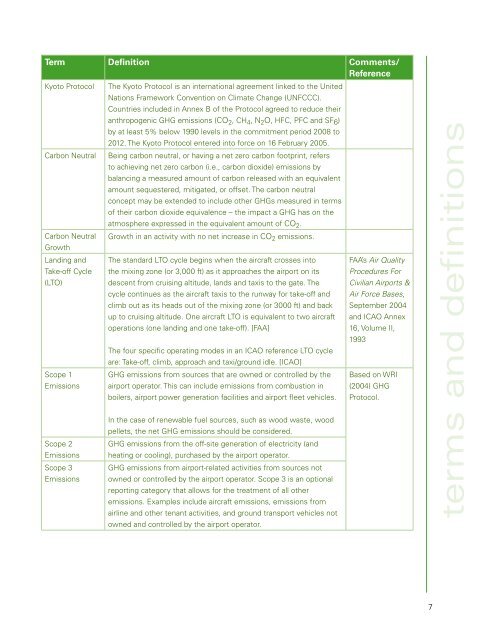Airport Greenhouse Gas Emissions Management - Zurich Airport
Airport Greenhouse Gas Emissions Management - Zurich Airport
Airport Greenhouse Gas Emissions Management - Zurich Airport
You also want an ePaper? Increase the reach of your titles
YUMPU automatically turns print PDFs into web optimized ePapers that Google loves.
Term Definition Comments/<br />
Reference<br />
Kyoto Protocol<br />
Carbon Neutral<br />
Carbon Neutral<br />
Growth<br />
Landing and<br />
Take-off Cycle<br />
(LTO)<br />
Scope 1<br />
<strong>Emissions</strong><br />
Scope 2<br />
<strong>Emissions</strong><br />
Scope 3<br />
<strong>Emissions</strong><br />
The Kyoto Protocol is an international agreement linked to the United<br />
Nations Framework Convention on Climate Change (UNFCCC).<br />
Countries included in Annex B of the Protocol agreed to reduce their<br />
anthropogenic GHG emissions (CO 2 , CH 4 , N 2 O, HFC, PFC and SF 6 )<br />
by at least 5% below 1990 levels in the commitment period 2008 to<br />
2012. The Kyoto Protocol entered into force on 16 February 2005.<br />
Being carbon neutral, or having a net zero carbon footprint, refers<br />
to achieving net zero carbon (i.e., carbon dioxide) emissions by<br />
balancing a measured amount of carbon released with an equivalent<br />
amount sequestered, mitigated, or offset. The carbon neutral<br />
concept may be extended to include other GHGs measured in terms<br />
of their carbon dioxide equivalence – the impact a GHG has on the<br />
atmosphere expressed in the equivalent amount of CO 2 .<br />
Growth in an activity with no net increase in CO 2 emissions.<br />
The standard LTO cycle begins when the aircraft crosses into<br />
the mixing zone (or 3,000 ft) as it approaches the airport on its<br />
descent from cruising altitude, lands and taxis to the gate. The<br />
cycle continues as the aircraft taxis to the runway for take-off and<br />
climb out as its heads out of the mixing zone (or 3000 ft) and back<br />
up to cruising altitude. One aircraft LTO is equivalent to two aircraft<br />
operations (one landing and one take-off). [FAA]<br />
The four specific operating modes in an ICAO reference LTO cycle<br />
are: Take-off, climb, approach and taxi/ground idle. [ICAO]<br />
GHG emissions from sources that are owned or controlled by the<br />
airport operator. This can include emissions from combustion in<br />
boilers, airport power generation facilities and airport fleet vehicles.<br />
In the case of renewable fuel sources, such as wood waste, wood<br />
pellets, the net GHG emissions should be considered.<br />
GHG emissions from the off-site generation of electricity (and<br />
heating or cooling), purchased by the airport operator.<br />
GHG emissions from airport-related activities from sources not<br />
owned or controlled by the airport operator. Scope 3 is an optional<br />
reporting category that allows for the treatment of all other<br />
emissions. Examples include aircraft emissions, emissions from<br />
airline and other tenant activities, and ground transport vehicles not<br />
owned and controlled by the airport operator.<br />
FAA’s Air Quality<br />
Procedures For<br />
Civilian <strong>Airport</strong>s &<br />
Air Force Bases,<br />
September 2004<br />
and ICAO Annex<br />
16, Volume II,<br />
1993<br />
Based on WRI<br />
(2004) GHG<br />
Protocol.<br />
terms and definitions

















